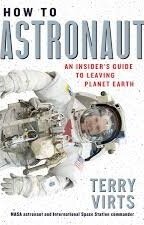“How to Astronaut: An Insider’s Guide to Leaving Planet Earth”
By Terry Virts
$27.95
Workman Publishing
310 pages
Life Among the Stars
by Fran Withrow 10.2021
Are you curious about astronauts? Do you wonder about what it takes to be one, and how it feels to be free from gravity? What’s it like to be at the International Space Station for an extended period of time? How do astronauts manage toileting, bathing, and eating? Do they get along with colleagues from other countries?
If you have ever gazed up in the sky and longed for more information about life beyond the confines of Earth, Terry Virts can tell you everything you ever wanted to know. “How to Astronaut” covers it all.
Virts started out as an Air Force fighter pilot before joining NASA and piloting the space shuttle Endeavour. He later served as the International Space Station commander, and his book is an easy, conversational read that answers all those space questions that have been keeping you up at night. In 51 essays, he discusses daily life on the International Space Station, traveling on a space shuttle, and even what the future might hold for space travel. His writing is warm and personable with a positive, upbeat outlook.
The essays can be read in any order, though Virts groups them by subject: Training, Launch, Orbit, Spacewalking, Deep Space, and Re-Entry. Each essay is relatively short and Virts is refreshingly honest about the challenges he faces, mistakes he makes (as well as those made by NASA), and what it takes to handle 200 days at the International Space Station.
Virts discusses all aspects of life in space. Even putting a suit on for a spacewalk is worth a chapter. Virts, for instance, has a large head and really struggles to get his helmet on. The suits for spacewalks are so tight a fellow crew member must help. And the challenge doesn’t end there: spacewalks themselves are exhausting. The astronauts can be outside the space station for hours, doing repairs or completing other tasks. It takes courage, a relentlessly positive attitude, and an understanding that survival is not guaranteed to be a successful astronaut.
The real reason for the existence of the space station mission is science. Virts says there were over 250 experiments going on during his stay on the space station. In addition to the usual investigations on mice and worms, the astronauts themselves are experiments. How does the human body tolerate extended days in space? What can we learn that might help us deal with diseases on earth, or prepare us for a trip to Mars? And speaking of Mars, Virts thoughtfully discusses how we might get there, and how realistic it is.
The chapter on re-entry to Earth convinced me that space travel is not on my bucket list. In addition to his own experience with re-entry, VIrts was present at the Columbia tragedy. Yet he also waxes eloquent about the beauty of earth as seen from above, the breathtaking vistas he witnesses and the fragility he notices about Earth, the only home we have.
A kindhearted, compassionate look at life among the stars, Virts has written an illuminating book about every aspect of traveling in space.

